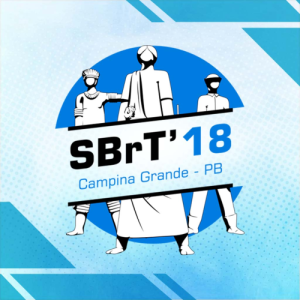
XXXVI Simpósio Brasileiro de Telecomunicações e Processamento de Sinais
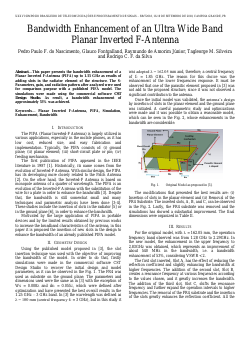
Bandwidth Enhancement of an Ultra Wide Band Planar Inverted F-Antenna
Pedro Paulo F. do Nascimento, Glauco Fontgalland, Raymundo de Amorim Júnior, Tagleorge M. Silveira, Rodrigo C. F. da Silva
DOI: 10.14209/sbrt.2018.135
Keywords: Planar Inverted F-Antenna PIFA Simulation Enhancement Bandwidth
Abstract
This paper presents the bandwidth enhancement of a Planar Inverted F-Antenna (PIFA) up to 1.55 GHz as results of adding slots in the radiator element of the structure. The SParameters, gain, and radiation pattern after analyzed were used for comparison purpose with a published PIFA model. The simulations were made using the commercial software CST Design Studio. As result, a bandwidth enhancement of approximately 53% was achieved.Download

Solução em Nuvem para Telemetria de Sistemas de Geração Baseada em Painéis Solares Fotovoltaicos
Leonardo H. C. Nunes, Jorge F. M. C. Silva, Francisco W. R. M. Junior, Cleiton S. Marinho, Carlos M. J. M. D. Junior
DOI: 10.14209/sbrt.2018.136
Keywords: Smart Grid Cloud Computing Telemetry Embedded Systems.
Abstract
This article presented one prototype for monitoring on photovoltaic generation system based on Embedded System, which data can access by cloud computing and has low cost. In the context, this hardware have a microcontroller, sensors and internet wireless communication module for integration with the cloud computing. Thus, the work insert to context in Smart Grid.Download
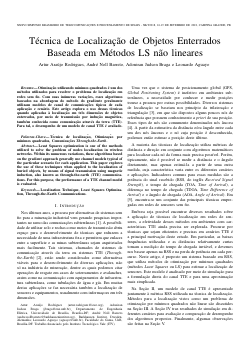
Técnica de Localização de Objetos Enterrados Baseada em Métodos LS não lineares
Artur Araújo Rodrigues, André Noll Barreto, Adoniran Judson Braga, Leonardo Aguayo
DOI: 10.14209/sbrt.2018.138
Keywords: Localization Technique Least Squares Optimization Through-the-Earth Communications
Abstract
Least Squares optimization is one of the methods utilized to solve the problem of nodes localization in wireless networks. Within its numerous variations, these algorithms based on the gradient approach generally use channel models typical of the particular scenario for each application. This paper explores the use of these techniques when applied to the localization of buried objects, by means of signal transmission using magnetic induction, also known as through-the-earth (TTE) communications. For this purpose, the performance of a TTE channel model is evaluated.Download
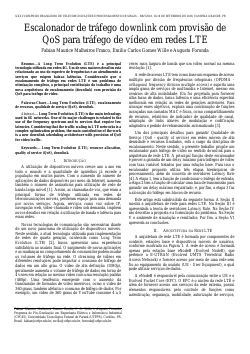
Escalonador de tráfego downlink com provisão de QoS para tráfego de vídeo em redes LTE
Fabian Maurice Malheiros Franco, Emilio Carlos Gomes Wille, Augusto Foronda
DOI: 10.14209/sbrt.2018.139
Keywords: Long Term Evolution (LTE) resource allocation quality of service (QoS) downlink
Abstract
Long Term Evolution (LTE) is the main technology used in 4G networks. One of its major challenges is related to the use of the frequency spectrum and to services that require low latencies. Considering that the traffic scaling in LTE networks is a complex optimization problem, the main contribution of the work is a new downlink scheduling architecture with provision of QoS for video trafficDownload
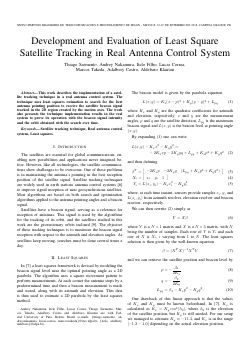
Development and Evaluation of Least Square Satellite Tracking in Real Antenna Control System
Thiago Sarmento, Andrey Nakamura, Itelo Filho, Adalbery Castro, Aldebaro Klautau, Lucas Correa, Marcos Takeda
DOI: 10.14209/sbrt.2018.142
Keywords: Satellite tracking technique Real antenna control system Least squares.
Abstract
This work describes the implementation of a satellite tracking technique in a real antenna control system. The technique uses least squares estimation to search for the best antenna pointing position to receive the satellite beacon signal tracked in the 2D region created by the motion axes. The work also presents the technique implementation results in the real system to prove its operation with the beacon signal intensity and the orbit obtained with the search over time.Download
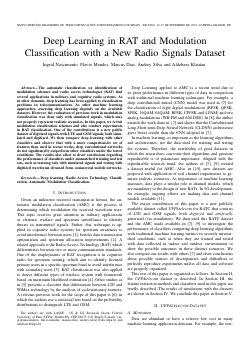
Deep Learning in RAT and Modulation Classification with a New Radio Signals Dataset
Ingrid Nascimento, Flavio Mendes, Marcus Dias, Andrey Silva, Aldebaro Klautau
DOI: 10.14209/sbrt.2018.144
Keywords: Deep learning Radio Access Technology Classification Automatic Modulation Classification
Abstract
The automatic classification (or identification) of modulation schemes and radio access technologies (RAT) find several applications in military and cognitive radio systems. As in other domains, deep learning has been applied to classification problems in telecommunications. As other machine learning approaches, assessing deep learning depends on the available datasets. However, the evaluation of previous work in modulation classification was done only with simulated signals, which may not properly represent realistic scenarios. In this paper, we revisit modulation classification schemes and also conduct experiments in RAT classification. One of the contributions is a new public dataset of digitized signals with LTE and GSM signals, both simulated and digitized. We then compare deep learning with other classifiers and observe that with a more comprehensive set of features than used in recent works, deep convolutional networks do not significanytly outperform other classifiers under the tested conditions. The results also allow to draw conclusions regarding the performance of classifiers under mismatched training and test sets, such as training only with simulated signals and testing with digitized waveforms obtained from commercial mobile networks.Download
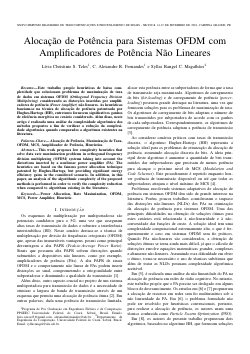
Alocação de Potência para Sistemas OFDM com Amplificadores de Potência Não Lineares
Lívia Christinie S. Teles, C. Alexandre R. Fernandes, Syllas Rangel C. Magalhães
DOI: 10.14209/sbrt.2018.145
Keywords: Power Allocation Rate Maximization OFDM MCS Power Amplifier Heuristic
Abstract
This work proposes low complexity heuristics that solve data rate maximization problems in orthogonal frequency division multiplexing (OFDM) systems taking into account the distortions inserted by a nonlinear power amplifier (PA). The heuristics are based on the famous power allocation technique patented by Hughes-Hartogs, but providing significant energy efficiency gains in the considered scenario. In addition, in this paper, an analysis of the algorithmic complexity of the proposed methods is performed in order to verify the complexity reduction when compared to algorithms existing in the literature.Download
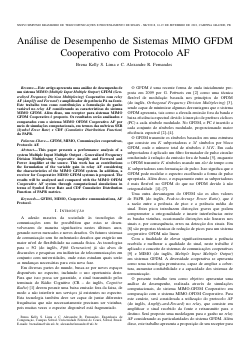
Análise de Desempenho de Sistemas MIMO GFDM Cooperativo com Protocolo AF
Brena Kelly S. Lima, C. Alexandre R. Fernandes
DOI: 10.14209/sbrt.2018.147
Keywords: GFDM MIMO Cooperative communications AF Protocol.
Abstract
This paper presents a performance analysis of a system Multiple Input Multiple Output - Generalized Frequency Division Multiplexing Cooperative Amplify and Forward and Power Amplifier at the source. This work has as contributions the formulation of the variable gain in relay AF considering the characteristics of the MIMO GFDM system. In addition, a receiver for Cooperative MIMO GFDM systems is proposed. The results will be analyzed and compared with the MIMO OFDM Cooperative AF system through computational simulations in terms of Symbol Error Rate and CDF Cumulative Distribution Function of PAPR metricsDownload

Adaptive Gain Methods to Improve Speech Intelligibility under Reverberation
F. de S. Farias, R. Coelho
DOI: 10.14209/sbrt.2018.163
Keywords: The reflection of an acoustic signal on walls or objects in an enclosed environment is perceived as reverbera- tion. It is present daily in conference rooms tunnels and any closed spaces. The presence of reverberation can degrade speech intelligibility and the performance of tasks that depend on it such as speech or speaker recognition. Many methods were proposed to attenuate this degradation. A family of such methods acts on clean speech applying gains on parts of the signal in order to improve intelligible when reverberated. These methods are called adaptive gain methods. This study aims to evaluate the effect of two adaptive gain methods Adaptive Gain Control (AGC) and Steady-State Suppression (SSS) in speech intelligibility. The evaluation uses four objective measures: Coherence Signal Intelligibility Index (CSII) Short Time Objective Intelligibility (STOI) Speech Reverberation to Modulation Ratio (SRMR) and Weighted Short Time Objective Intelligibility (WSTOI). Results show that AGC improves speech intelligibility in studied conditions while SSS degrades it a result in line with subjective measures found in the literature.
Abstract
The reflection of an acoustic signal on walls or objects in an enclosed environment is perceived as reverbera- tion. It is present daily in conference rooms, tunnels and any closed spaces. The presence of reverberation can degrade speech intelligibility and the performance of tasks that depend on it, such as speech or speaker recognition. Many methods were proposed to attenuate this degradation. A family of such methods acts on clean speech, applying gains on parts of the signal in order to improve intelligible when reverberated. These methods are called adaptive gain methods. This study aims to evaluate the effect of two adaptive gain methods, Adaptive Gain Control (AGC) and Steady-State Suppression (SSS), in speech intelligibility. The evaluation uses four objective measures: Coherence Signal Intelligibility Index (CSII), Short Time Objective Intelligibility (STOI), Speech Reverberation to Modulation Ratio (SRMR) and Weighted Short Time Objective Intelligibility (WSTOI). Results show that AGC improves speech intelligibility in studied conditions, while SSS degrades it, a result in line with subjective measures found in the literature.Download
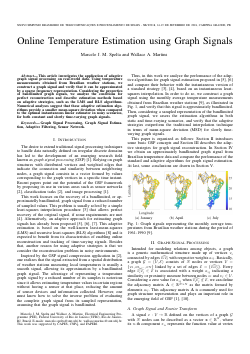
Online Temperature Estimation using Graph Signals
Marcelo J. M. Spelta, Wallace A. Martins
DOI: 10.14209/sbrt.2018.164
Keywords: Graph Signal Processing Graph Signal Estima- tion Adaptive Filtering Sensor Network
Abstract
This article investigates the application of adaptive graph signal processing on real-world data. Using temperature measurements obtained from Brazilian weather stations, we construct a graph signal and verify that it can be approximated by a sparse frequency representation. Considering the properties of bandlimited graph signals, we analyze the conditions for perfect reconstruction and describe estimation methods based on adaptive strategies, such as the LMS and RLS algorithms. Numerical analyses suggest that these adaptive estimation algo- rithms provide a smaller mean-square deviation when compared to the optimal instantaneous linear estimator in noisy scenarios, for both constant and slowly time-varying graph signals.Download